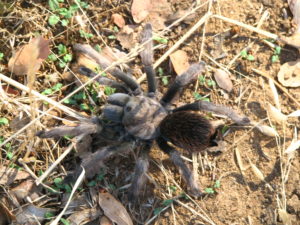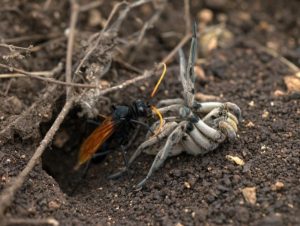Aphonopelma

Photo © Robert Siegel, MD, PhD, Stanford University. Used with permission.
With large fangs, eight hairy legs, and an overall appearance that is both frightening and cute, tarantulas are one of the most recognizable spider species, and rightly so. They are the largest spiders in the world, with the largest California species reaching adult leg spans of 4.5 inches. Various tarantula species can be found throughout the world in a wide range of habitats, from tropical jungles to grasslands, and temperate rainforests to deserts.
There are 29 distinct species of tarantulas in the United States, 10 of which are found in California, each with different body and leg sizes, colors, genetic variation, and geographic distributions. Three of these tarantula species are found in the Los Padres (A. iodius, A. steindachneri, and A. eutylenum), and they are usually seen slowly crawling across roads and trails at dusk or during the breeding season in the Fall, looking for mates.
The hairs on their abdomen and legs are called “urticating hairs,” which can be rubbed off by the spiders as a defense mechanism when threatened. These hairs then fly into the air and irritate the provoker’s eyes and respiratory system, distracting it and allowing the spider to escape. Tarantulas primarily hunt insects and other arthropods, using ambush methods rather than spinning intricate webs; larger tarantula species are capable of hunting small vertebrates like frogs, lizards, mice, and even birds. Despite their intimidating appearance, the vast majorities of tarantulas are not dangerous to humans and are actually quite docile.
The breeding season occurs between autumn and winter, with the majority of activity occurring in October. After breeding, the male must make a quick escape or risk being eaten by the cannibalistic female. It takes approximately 6-9 weeks for the 700-1000 eggs to hatch.

A tarantula creeps its way across a dirt road in the Los Padres National Forest.
Female tarantulas are more secretive and difficult to find than males, preferring to spend most of their time underground. They are also more long-lived, with a lifespan averaging around 15-20 years. Some species are even known to live for up to 40 years! Males are more likely to be found wandering on the ground at dusk after emerging from their burrows to seek potential mates, and have shorter lifespans than females, usually living only around 5-7 years. Both male and female tarantulas hunt from their burrows, spinning thin silk webs that allow them to move easily underground and to easily detect vibrations from passing prey. Rather than use their webs to trap prey, tarantulas quickly burst from their burrows to capture and paralyze prey with a venomous bite.
Of the few natural predators that tarantulas have, one notable predator is a species of wasp called the tarantula hawk, which hunts tarantulas with clawed legs and quarter inch stingers that permanently paralyze them. The tarantula hawk’s young are actually parasitic. After a female tarantula hawk lays a single egg on the tarantula’s abdomen, the resulting larva then bites a hole in the spider and feeds on its tissues, avoiding vital organs to keep the spider alive for as long as possible. However, by the time the larva undergoes metamorphosis and emerges from the spider’s abdomen as an adult wasp, the unfortunate spider has met a grisly demise.

A tarantula hawk drags a paralyzed tarantula into its burrow. Photo © Dale Jackan.
Despite the tarantula’s unpleasant appearance, most species are harmless towards humans and provide a beneficial ecosystem service of keeping insect populations in check. These incredible long-living, complex spiders have adapted to many environmental conditions all over the world for millions of years and will probably remain for many more to come.






